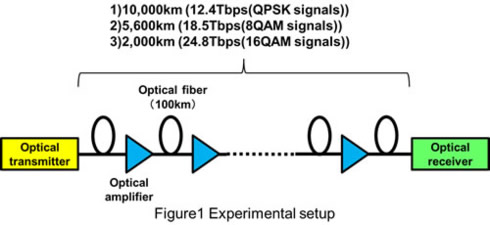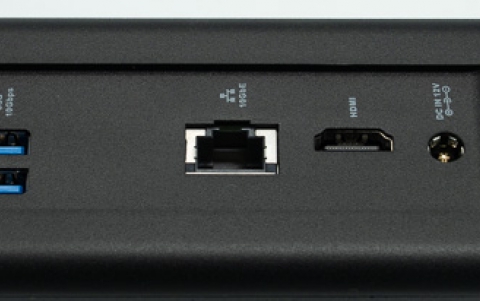
Fujitsu, NTT, and NEC To Commercialize 400Gbps-class Optical Transmission Technology
Fujitsu Limited, NTT Corporation, and NEC Corporation today have achieved a successful transmission test of the world's top-level, 400Gbps/channel-class digital coherent optical transmissions technology, marking a step toward commercialization. The test, with 400Gbps-class signals multiplexed up to 62 channels, verified fiber-optic transmissions of 12.4-24.8 Tbps wavelength division multiplexed signals having different capacities for each modulation method at distances ranging from several thousand kilometers up to 10,000km.
By implementing this technology in an optical transceiver, a quadrupling of optical transmissions was achieved while using existing optical fiber, enabling the construction of the world's top-level core network, with the ability to handle transmissions of ultra-high-definition videos and the widespread expansion of machine-to-machine (M2M) communications.
Building on these results, the companies will accelerate efforts to commercialize 400Gbps-class optical transmission technology.
How it works
The key technologies that enabled ultra-high speed optical transmission of 400Gbps-class/channel are as follows:
In addition to Quadrature Phase Shift Keying (QPSK), which is used in existing 100Gbps transmissions and which superimposes information on the phase of the light, an 8 Quadrature Amplitude Modulation (QAM) and a 16 QAM were used, superimposing information on both the phase and amplitude of the optical waves to expand data volume, and combined with sub-carrier multiplexing enabled by spectral compression technology called Nyquist filtering. By use of these technologies, an ultra-high speed optical transmission of the world's top-level 400Gbps-class was achieved, allowing for a much higher volume of information to be transmitted compared to that of conventional methods.
In particular, in response to the characteristics of the optical transmission links, by selecting a modulation format appropriate for the quality of the link, in regards to the adaptive modulation/demodulation technology that enables the application of efficient optical network resources, the companies developed the first algorithm that can be implemented in an electronic circuit including an 8 QAM. Transmission ranges of 500 km to 1500km for capacities of 10 - 20Tbps per each core of optical fiber were successfully covered, which was not possible up until now, even with QPSK and 16 QAM. Therefore, the same hardware can support various modulation/demodulation formats in response to the conditions of the transmission line, such as transmission distance, enabling a highly adaptable and flexible network.
To achieve 400Gbps-class, ultra-high-speed optical transmissions over long distances, it is necessary to compensate for complex waveform distortions caused by nonlinear optical effects, which are generated with the optical fiber's refractive index changes in accordance with the intensity of the optical signal as high-power optical signals enter the optical fiber. These distortions would otherwise limit the power of incoming optical signals into the optical fiber.

Up until now, however, compensating for the nonlinear optical effects of multi-level modulation signals within the optical fiber was difficult because the extremely large scale of the circuit made circuit implementation difficult. Therefore, it has been the primary limiting factor standing in the way of extending the distance of transmissions.
To overcome this problem, the companies developed digital backward propagation signal processing, which, through refinements to the algorithm and circuit designs that dramatically reduced the volume of calculations, enabled circuit implementation and compensation of the nonlinear optical effects. They also developed chromatic dispersion estimation technology enabling estimations, for 10,000km of optical fiber, of the values of chromatic dispersion, which is a phenomenon in which the propagation lag times differ for each wavelength in an optical fiber. Moreover, a high-performance MSSC-LDPC error-correction code was used to enable a further extension of transmission distances. As a result of these technologies, the amount of equipment needed for long-haul transmission can be reduced, leading to expectations that the network would also consume less electricity.





















